By now the winter flood is off from most New Jersey cranberry beds. Once the water is removed, the vines will start to initiate bud break. From now until bloom, growers should scout their beds using sweep net sampling for lepidopteran pests (blackheaded fireworm, spotted fireworm, Sparganothis fruitworm, and cranberry blossomworm), and blunt-nosed leafhoppers.
Blackheaded fireworm – Blackheaded fireworm eggs overwinter on the bed and usually hatch by around mid-May. It is important to catch
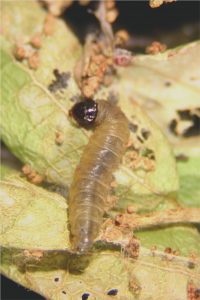
Figure 1. Blackheaded Fireworm Larva
the first generation, if possible, because the second generation occurs during bloom and is typically much more destructive. Blackheaded fireworm larvae (Figure 1) can be detected by sweep net sampling and it is a good idea to look along the edges of beds where vines first begin to grow. Remember: blackheaded fireworm is much easier to control if detected during the early part of the season.
Spotted fireworm – This insect overwinters as a 2nd instar larva. They complete two generations a year. Larvae (Figure 2) feed between uprights they have webbed together. First-generation larvae injure the foliage causing it to turn brown as if burned. In New Jersey, first generation adult moths emerge the first week of June, followed by a second-generation of adult emergence in early August. Eggs are laid in masses on weedy hosts. Larvae from second-generation adults emerge in mid-August and may feed on fruit. Populations of spotted fireworm are regulated by their natural enemies, in particular Trichogramma wasps that parasitize the eggs.
Sparganothis fruitworm – This insect is a serious pest in most cranberry-growing states. Sparganothis fruitworm completes two generations a year and overwinters as an early-instar larva. Larvae (Figure 3) from the 1st generation feed on foliage. In New Jersey, first generation adult moths emerge from mid-June through the first weeks in July; pheromone traps are commonly used to monitor adult flight and population size. Second-generation eggs are laid on
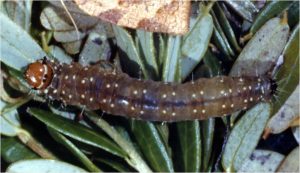
Figure 2. Spotted Fireworm Larva
cranberry leaves, and larvae will feed on fruit.
Cranberry blossomworm – Adults lay their eggs in October in cranberry beds. The eggs overwinter and hatch over a period of several weeks. Early instars can be found during the first week of May. Larvae go through 6 instars to complete development. Because the first instars feed during the day (and at night), scouting can be done during the daytime using sweep nets to estimate larval abundance. Larvae turn nocturnal during the later instars (Figure 4). At this time, night sweeping (9 pm – 1 am) is recommended for sampling. Larvae complete their development by June-July. Older instars are very voracious and capable of destroying 100 blossoms within a 3-week period. There is a pre-pupal stage that lasts until the end of August and a pupal stage that lasts until October. Adults emerge from the end of August to the end of October.
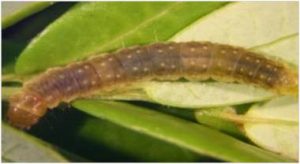
Figure 3. Sparganothis Fruitworm Larva
Lepidopteran Pests Monitoring and Control – Use sweep netting for monitoring early lepidopteran pests (pre-bloom) (Figure 5). A sweep set consists of 25 sweeps and 1 sweep set is recommended per acre (this may vary depending on the size of bogs). The action threshold for false armyworm, blossomworm, other cutworms, and gypsy moth (we use a combined threshold from adding all these caterpillars per sweep) is an average of 4.5 caterpillars in sets of 25 sweeps. For brown and green spanworms is an average of 18 per sweep set. The action threshold for blackheaded fireworm and Sparganothis fruitworm is an average of 1.5 per sweep set. We recommend the use of reduced-risk materials such as the insect growth regulator (IGR) Intrepid, the spinosyn insecticide Delegate or any of the diamide insecticides Altacor, Exirel or Verdepryn if populations exceed action thresholds. These are reduced-risk, softer insecticides that are very effective against lepidopteran pests. Remember to rotate insecticides with different modes of action to prevent onset of
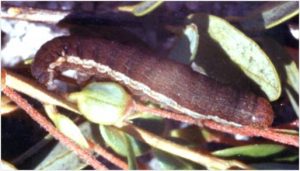
Figure 4. Cranberry Blossomworm Larva
insecticide-resistant pest populations.
Leafhoppers –There is continuing concern among New Jersey cranberry growers of a potential increase in leafhopper populations because of changes in pest management strategies (e.g., adoption of new reduced-risk products and decreased applications of broad-spectrum insecticides). Blunt-nosed leafhopper is of particular concern because they can transmit cranberry false blossom disease. This leafhopper has one generation a year. The adults are found in highest numbers during July, although nymphs or adults may be found from the end of May until October. Eggs are laid in August-September. The eggs overwinter and hatch in May or June. The nymphs (Figure 6) go through 5 instars to complete development.
Leafhopper Monitoring and Control: Leafhopper nymphs can be sampled using sweep nets (as described above for lepidopteran pests)
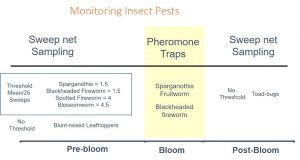
Figure 5. Monitoring Insect Pests of Cranberries
(Figure 5). Nymphs before bloom are small; thus, you may need to freeze the samples (to kill them), and then count the number of nymphs under a microscope or using a magnifying lens. Although there is no established threshold based on sweep net counts, we propose the following tentative thresholds: 20 nymphs per sweep set in young beds, new varieties, and/or with false blossom incidence; and 40 nymphs per sweep set in older beds, older varieties, and no incidence of false blossom. These decisions should be made also by comparing current numbers with prior infestation history.
In cases of high numbers of blunt-nosed leafhopper nymphs, we recommend application of a broad-spectrum insecticide, such as Sevin, Diazinon (no aerial applications allowed) or Lorsban (only pre-bloom applications allowed for Ocean Spray growers) (Figure 7). Broad-spectrum insecticides will disrupt biological control
particularly the natural enemies (predators and parasitoids) of Sparganothis fruitworm, so their use should be restricted only to areas of high leafhopper populations. Alternatively, growers can use Closer (sulfoxaflor). In our insecticide trials, Closer has shown good-to-excellent leafhopper control. This insecticide cannot be used when bees are active (i.e., between 3 days prior to bloom and until after
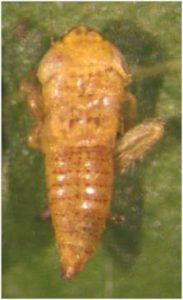
Figure 6. Blunt-nosed Leafhopper Nymph
petal fall).
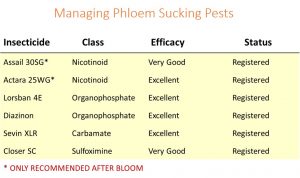
Figure 7. Leafhopper Control Options

